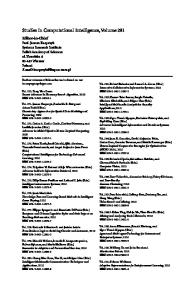Adaptive Learning Environments
- PDF / 5,597,476 Bytes
- 406 Pages / 547.087 x 737.008 pts Page_size
- 30 Downloads / 393 Views
Synonyms Comparative cognition; Emergent learning; Rational behaviorism
Definition The perspective that responses are elicited by stimuli to which they have become associated or learned because they are reinforced remains strongly entrenched in psychological thought. Just what reinforcers are and how they operate, perhaps as agents that bond responses to stimuli, are unresolved issues. The most generally accepted definition of a reinforcer is that it is an event that increases the probability that a response will reoccur if it is reinforced. But that definition is circular and does not explain how reinforcement works. Here, we outline a perspective on learning called Salience Theory that offers a process by which learning occurs across instances of stimulus pairings and the resultant sharing of response-eliciting processes that occur.
Theoretical Background Despite its popularity and robust history, this stimulus– response–reinforcement formulation has inherent weaknesses. How can radically new and creative behaviors suddenly occur in the absence of a training history
that included those behaviors? How does the fixedness that inheres in response reinforcement give way to the emergence of new behaviors and concepts, such as complex musical compositions and groundbreaking inventions? The Salience Theory of Learning proposes a new approach to account for the origins of novel, unexpected, and even intelligent behaviors and new abilities (e.g., competence in speech comprehension). It reformulates reinforcement and how it has its effects upon learning and behavior in terms of its salience, stimulus strength, and response-eliciting properties. Indeed, it formulates the contributions, the impact of all stimuli in the formation of our basic unit of learning, amalgams, in precisely those same terms. We know that what is trained via specific reinforcement of specific responses does not necessarily constrain what is learned (Rumbaugh and Washburn 2003). How can this be according to Reinforcement Theory? What the subject learns might well be far more complex and even qualitatively different from the behavior that one specifically reinforced. For instance, a rhesus monkey (Macaca mulatta) was trained with reinforcement over the course of several months and thousands of training trials to control a joystick with its foot in a complex interactive computer task. Use of a hand was precluded, hence never trained. Only in a later test was the monkey given its very first opportunity to use either its hand or foot to do the task. Now, since all reinforced training had been with its foot, use of its hand should have been at most a remote probability. Yet, when given a choice, the monkey promptly used its hand, scoring significantly better than it had ever done with its foot. Clearly, this finding is inconsistent with Reinforcement Theory. That the monkey used its hand might be said to reflect its massive and prior history in the use of its hand for fine manipulations of objects and foods, but that does not answer the stronger question
Data Loading...











